
Every year, the wish list grows. Proposals are abound for exploration and colonization outside the Pale Blue Dot we call home. Bullish billionaires are buying property on pre-populated planets and tagging invisible air rights above our stratosphere. Others render billboards of exotic sci-fi paradises, using them as lures to entice eager extra-terrestrial seekers. Many are grasping. But what will it take to ultimately push us out there? Will humankind’s big leap to outer space be guided by opportunity, or perhaps forced through catastrophe?
“The meaning, the purpose, and the patterns of life on Earth will also be considerably altered. The Earth might be regarded as a historical museum, a biological preserve, a place which contains harsh climate and uncontrolled weather for those who love physical adventure, or a primitive and primeval place for tourism.” - quote from Space Settlements
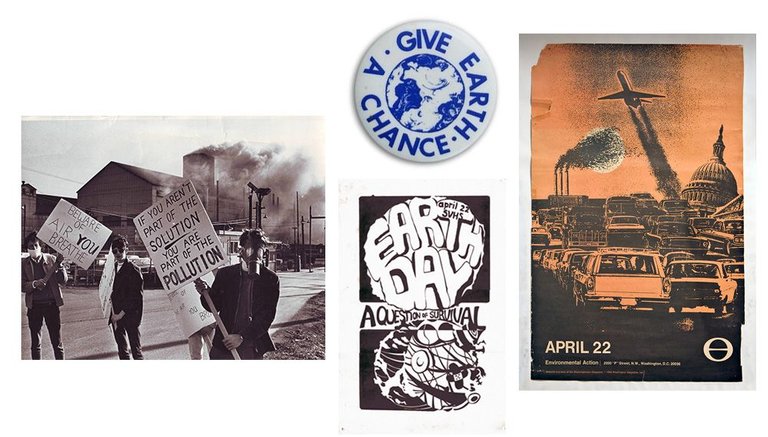
Advancement through Curiosity or Fear?
What motivates us? Maybe a bit of both. The mid 1970’s represented a turbulent time for our environment. Planetary health was a big topic both culturally and politically around the world. The American public in particular was at war with itself over worldwide pollution, CO2 emissions, ozone layers and habitat loss. The first Earth Day celebration (in 1970) fought to embed a modern voice with respect to a planet being trampled by traditional industry.
Fear was in the air, but so was curiosity. For one project in particular, it seems as if a mix was necessary. In 1975, astrophysicists from NASA began plotting for the big picture. Inspired by action on the ground, they wondered what could be done to provide for a sustainable future in the sky.
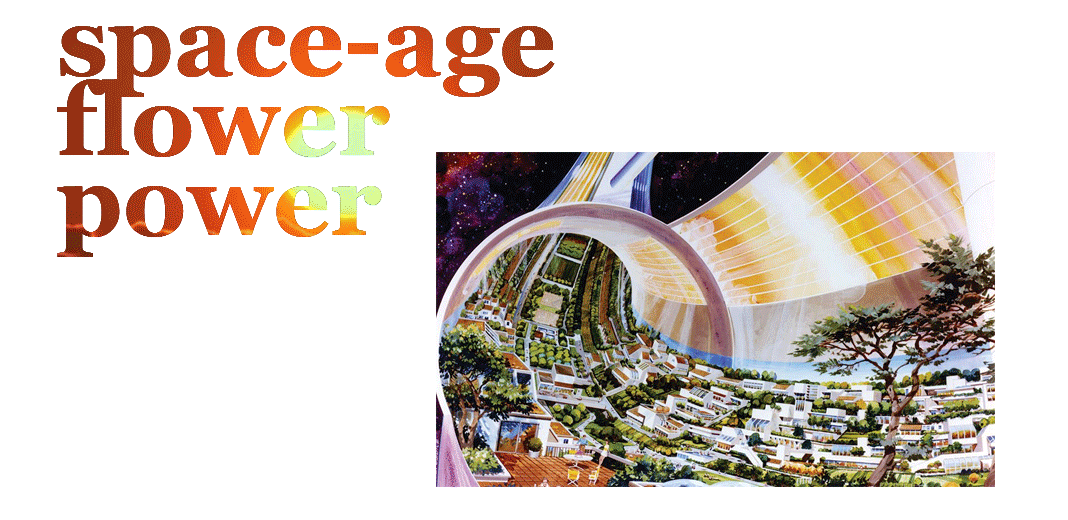
Flower Power
In the summer of ’75 NASA kickstarted an interdisciplinary team of forward thinkers. The program included architects, urban planners and engineers all tasked with developing schematics and whitepapers for space colonies. The Ames Research Center became a hub for coneptual space-age civilization.
The program detailed dozens of proposals with scales of orbiting cities ranging from 10,000 humanoids up to numbers in the trillions. The comprehensive designs covered everything from prefabricated housing, gender ratios broken down by trade, to the feasibility of a moon-ore-mining economy. The massive orbiting landscapes challenged engineers to navigate capacities for new civilizations and healthy climates. Embedded in all of this material was a unique and timely sense of empathy. At a time when habitats were being ripped apart, NASA sought to cultivate a modern sense of earthly stewardship.
“The key advantage of space settlements is the ability to build new land, rather than take it from someone else. This allows a huge expansion of humanity without war or destruction of Earth’s biosphere. The asteroids alone provide enough material to make new orbital land hundreds of times greater than the surface of the Earth, divided into millions of colonies. This land can easily support trillions of people.” quote from Space Settlements
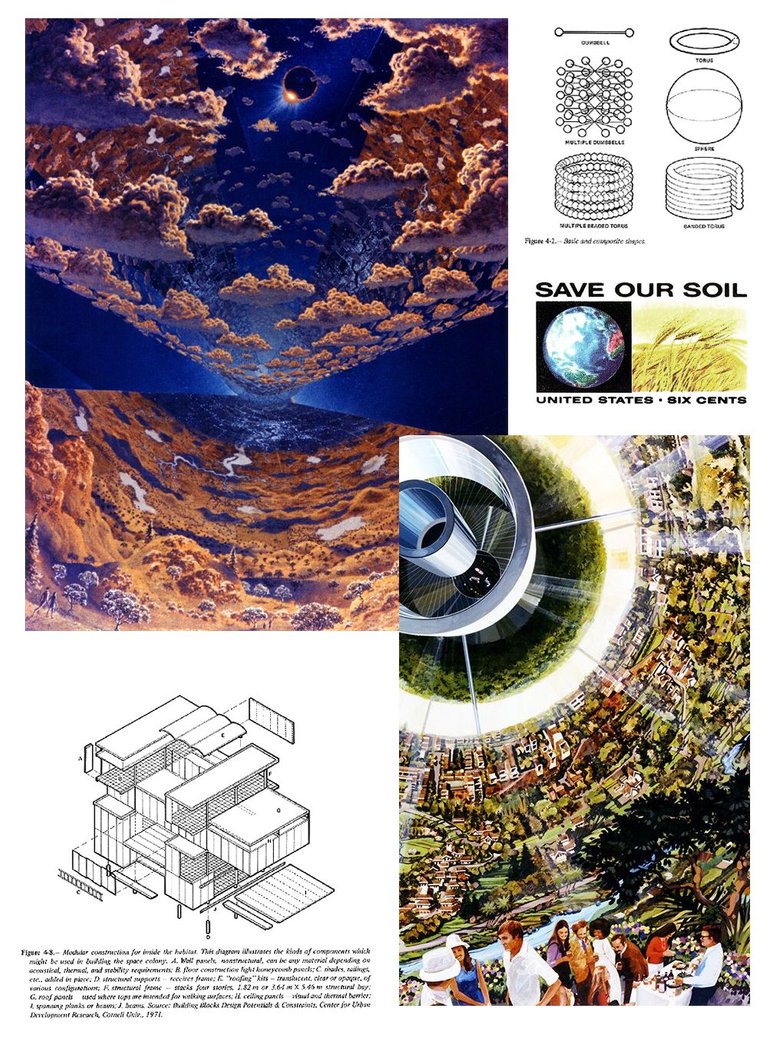

Futurist Form-making
Inspired by the space age, futurist architectural thinking of the late 1960's and early 70's was unleashed onto its largest and most mysterious canvas. These illustrations (by Don Davis) channelled the engineering and architectural research orchestrated by the Center for Urban Development Research, at Cornell University in 1971.
Modular housing for humanoid habitats made space look a lot like home. These drawings were the beginnings of renderings from outer space looking back at our beautiful earth.
“The concept of spacecraft Earth, a sphere of finite resources and ominous pollution, became pervasive and powerful at the same time we first received good photographs of our planetary home. The study summarized in this volume is another mind-stretcher. As explained on the following page, settlement in space is not an authorized program, and no man can now say if or when such a dazzling venture may be formally undertaken. But by their efforts to put numbers on an idea, to assess the human and economic implications as well as technical feasibility, the participants in this effort have provided us with a vision that will engage our imagination and stretch our minds.” - Foreword from Space Settlements
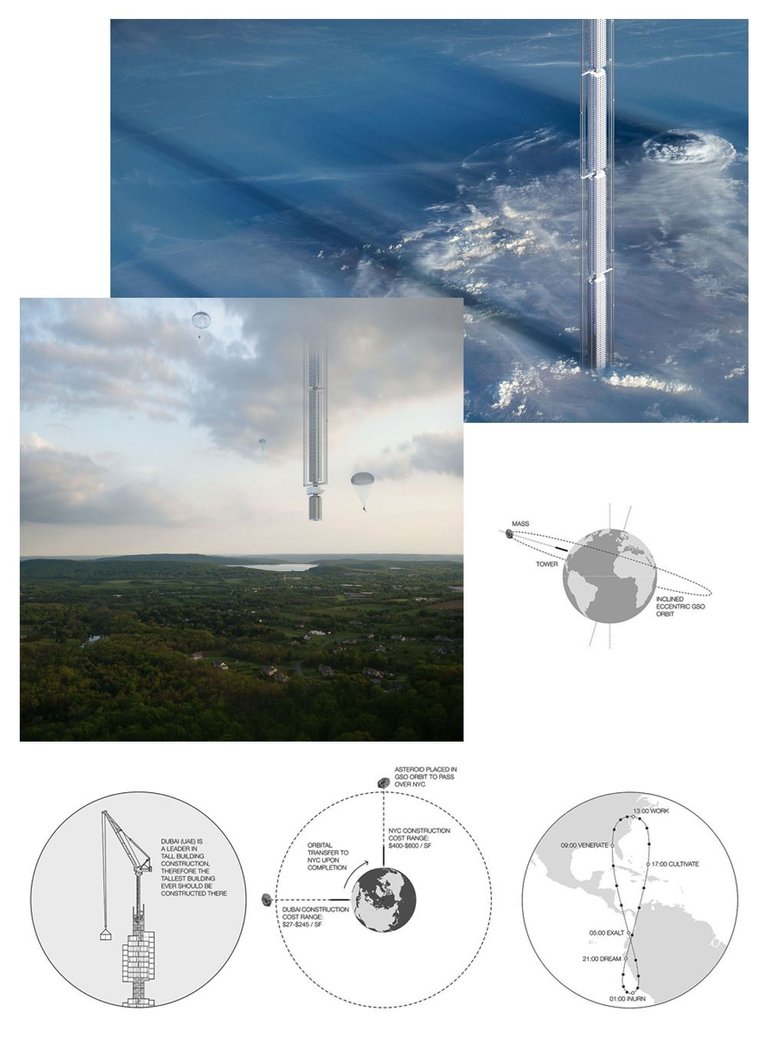
The illustrations above represent two futuristic concept structures that dip ominously through the layers of Earth's atmosphere. One proposal, titled "Analemma" is by Clouds Architecture Office. This tower design seeks structural support from artifacts hovering in the great beyond. Using the Universal Orbital Support System (UOSS) the space-building connects to a series of high-strength cables. The tower is free to orbit the Earth along the same coordinates as the Asteroid. Migrating throughout the day, the uses of the inside of the tower reflect the climates below.
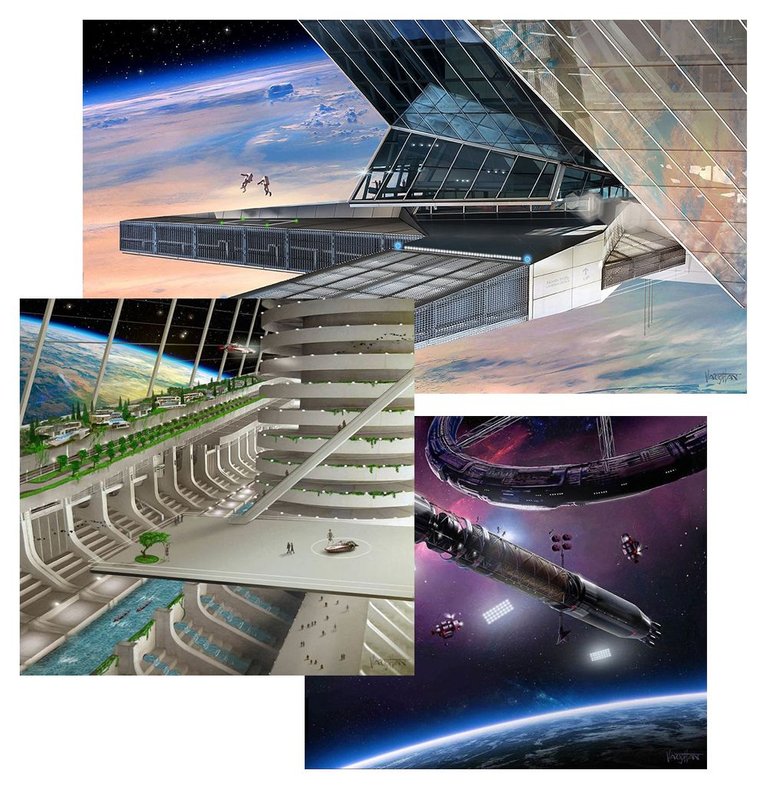
The Asgardia space colony is another example of Earthly rules being projected onto Alien territory. The project (above) already has 150,000 citizens awaiting their new home.
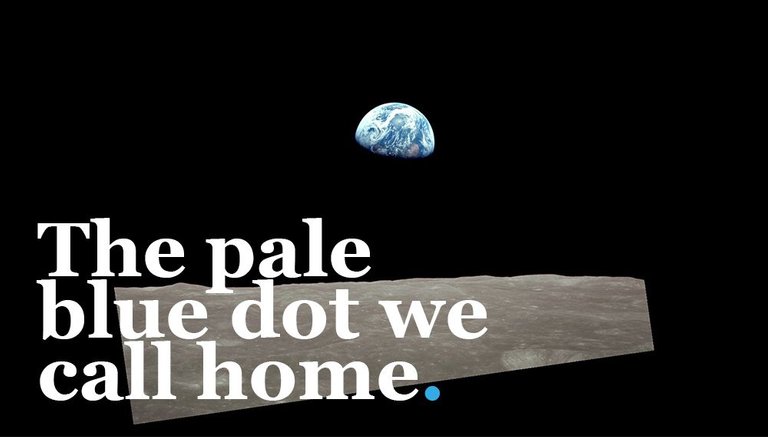
Stretching Minds Through the Looking Glass
"... there is perhaps no better demonstration of the folly of human conceits than this distant image of our tiny world. To me, it underscores our responsibility to deal more kindly and compassionately with one another and to preserve and cherish that pale blue dot, the only home we’ve ever known.” - Carl Sagan (1996)
The Pale Blue Dot gave us perspective. A view from up top looking down exposed a type of empathy that humanity hadn’t previously experienced. Surrounded by an infinite black abyss, we saw that Earth is a sapphire. We re-discovered the rare moment in time that we are all a part of.
Every utopia needs a good view, right? All of these fantastic proposals have a key and colorful backdrop, Earth. This interplanetary nostalgia is an important thing to emphasize. There’s a lot to learn from the way in which we render our space-age fantasies. Each of these proposals has a beautiful view of Earth. But why?
Ultimately, are we celebrating our birthplace, or memorializing our mistakes?
Sources
“Space Settlements : A Design Study" produced in 1975 by the NASA Ames Research Center.
“Pale Blue Dot" written in 1996 by Carl Sagan.
Collage Materials
"A Giant Step or Springtime Skip" graphic used for collage."Pollution" graphic used for collage."Tell Your Mother I Love Her" graphic used from WIRED."A Question of Survival" graphic used for collage."Give Earth a Chance" graphic used for collage."Earthrise" NASA image used for collage.

It would appear there are 2 options,,,,, we blow ourselves up while continuing to pollute the world,,,,, or we grow up as a species and finally become "humane", finaly become "civilized" and take care of everyone and everything.
Here is Option 2 (a lot like a Star Trek Economy).
BTW,,,, the Carl Segan "Pale Blue Dot" is like one of the BEST Video Clips EVER !!!!
I'm obsessed!
It's absolutely amazing to me that this cryptocurrency habitat we're building (Steemit + beyond) is actually providing real infrastructure to flip our debt-dependencies. We're all a bunch of utopian-loving bloggers... but now there's actual technology that's pushing all of these practices to the forefront.
Maybe crypto/blockchain will be infrastructural (and idealogical) boost we need to expand into space?
Yes!!! Resource based economy is an idea that needs to be realised. I can't wait for that day. I hope I live to see it.
Me too my new sister !!!!
Success or mistakes? Hard to say... I look around me and observe what we have done in the course of just the past century and it always comes back to it feeling like there's an eternal struggle between selfishness and greed... and idealism and altruism.
I don't know where it will all end. I have noticed a number of recent sci-fi series and movies where the current International Space Station still existed as the "core" of a much larger structure... and maybe that's what we're best at, as a species, "building on top of what already exists."
I really like that. We're adaptive by nature - and that typically requires a MacGyver-ing of existing resources in order to survive.
I'm strangely nostalgic (with respect to something I'll never visit) but I do hope we use the ISS as a core for a larger move into Space.
I was just writing a piece "What on Earth is Happening?", got stuck, surfed Steemit and saw this post while listening to this https://vektroid.bandcamp.com/track/blood-from-a-stone. Now I'm unstuck. Always liked futurist pieces that weave nice stories and paint great pictures of tomorrow etc. I think we're now at a phase of building out open-infrastructures (energy and information platforms) that could expand all scope of human innovation. Even by connecting 1% of our time and effort through well curated stories and communities, we may find people that we can all relate to and start building something worthy together.
Now I'm just happy that my Steem vote can support nice posts like this :P. Great post!
Likewise, the occasional blockchain surf un-sticks me. I'm glad this article could help :)
I was going off of https://chromesparks.bandcamp.com/ while writing this post btw. I wholeheartedly agree Kevin, if we can begin to connect our time, and our experiences - we can build something monumental together. Who knows, maybe digital currencies will incentivize the big leap we need to push our world further.
Looking forward to your next piece!
This photograph, taken by Apollo 17 astronauts on December 7, 1972, shows Earth almost fully illuminated. The astronauts had the Sun behind them when they took the image just over 5 hours after launch. Apollo 17 was the last manned lunar mission. No human since has been far enough from Earth to photograph a whole-Earth image such as this, which became known as The Blue Marble. (Source)
I remember it like yesterday.
Such a powerful image!
You know, when the photograph was taken, the Earth was flipped. People seem to like north at the top - even at the expense of authenticity.
So was there a moment in the history of map-making that made North "Up" and South "Down?" This is fascinating.
In the case of this photograph, the way the astronauts' were holding NASA's 70-millimeter Hasselblad with an 80-millimeter Zeiss lens it was capturing south on "top." In presenting the image to the public, prints were turned 180 degrees so that north was on top.
beautiful
I love the Mass Effect’s citadel in the post 😁 basically, mankind ruined earth so it is searching for a new environment to exploit.
Just hopping between worlds, sopping up the oxygen...
Hello ! I just read your content, I love it. I thank you for this kind of publication. Follow me @meranie and I follow you too!
This is quite detailed. This is enough science for tonight, very educative. The pale blue dot might be the biggest thing many of us will ever see.
Thank for the kind words @jaff8 - it's both the biggest and the smallest...
It is so interesting to see what a small dot could contain. I have never really imagine living outside the dot for a moment, have you thought of leaving? Maybe in some years time, we'll be chatting from different "worlds".
Maybe each colony will communicate via their own SMT ;)
The earth will forever remain man's only home, no other planet has been so intelligently designed to sustain life. Let's protect it.
Well said @kevaton. Let's not take this beautiful and complex home for granted.
Thanks @voronoi
Very well-written piece - well done :)
We are all crypto “utopians” already and I wish that we could really learn from our mistakes before we “blowup”.
Well said @mammasitta! Here's hoping we learn from our past to better our future.
The concept of establishing an extraterrestrial colony has been an age-long proposition. But thankfully, a new discovery of Martian cave is set to fast-track the whole process. Now, Mars could hold the first ever space colony. Let's keep our fingers crossed though
That would be super cool! Hopefully we see this happen in our lifetime.
We need to rethink everyting we know about the space they teach us. the pale blue dot has been proven to be false (with any specialized software), anyone can cross the Van Allen belts, any ship can move on the vacum space. too many fantasy they told us.
Excellent article.. well written.. :)
Thank you, glad you enjoyed it :)
Thanks for bringing this into steemit!
Amazing that these studies were made 40-50 years ago.
i think ,this article helps us to notice ourselves,What we are? what we were? Why the condition of the world is so worst ? by reading your article,i become thoughtful, hopeful. {NASA kickstarted an interdisciplinary team of forward thinkers. The program included architects, urban planners and engineers all tasked with developing schematics and whitepapers for space colonies. The Ames Research Center became a hub for coneptual space-age civilization.} specifically this make me hopeful. thanks a lot to provide us this kind of inforfation
https://steemit.com/@shahin007
it will be really interesting with the kind of innovations going on
I love letting my mind wander into the future like this. For me what is exciting is that we are now getting to a point in our history whereby we can address the elephant in the room.
That being; space is incredibly inhospitable, and despite the resource issue humans cannot survive very long outside of Earth's atmosphere. Even on Mars, the lack of a magnetosphere means the likelihood of getting cancer is a thousandfold of what it is on Earth.
However we are now moving into this age of transhumanism, where by we can alter and assist our biology. I don't know how future earth will look like, but I'm fairly sure future humans won't look (internally at least), anything like us.
Cg
One wonders what unanticipated disruptive events might be lurking in our collective future over which we may be powerless...
this earth will be a robotic world..
Come and learn what activities AI likes :)
Congratulations @voronoi! You have completed some achievement on Steemit and have been rewarded with new badge(s) :
Click on any badge to view your own Board of Honor on SteemitBoard.
For more information about SteemitBoard, click here
If you no longer want to receive notifications, reply to this comment with the word
STOP